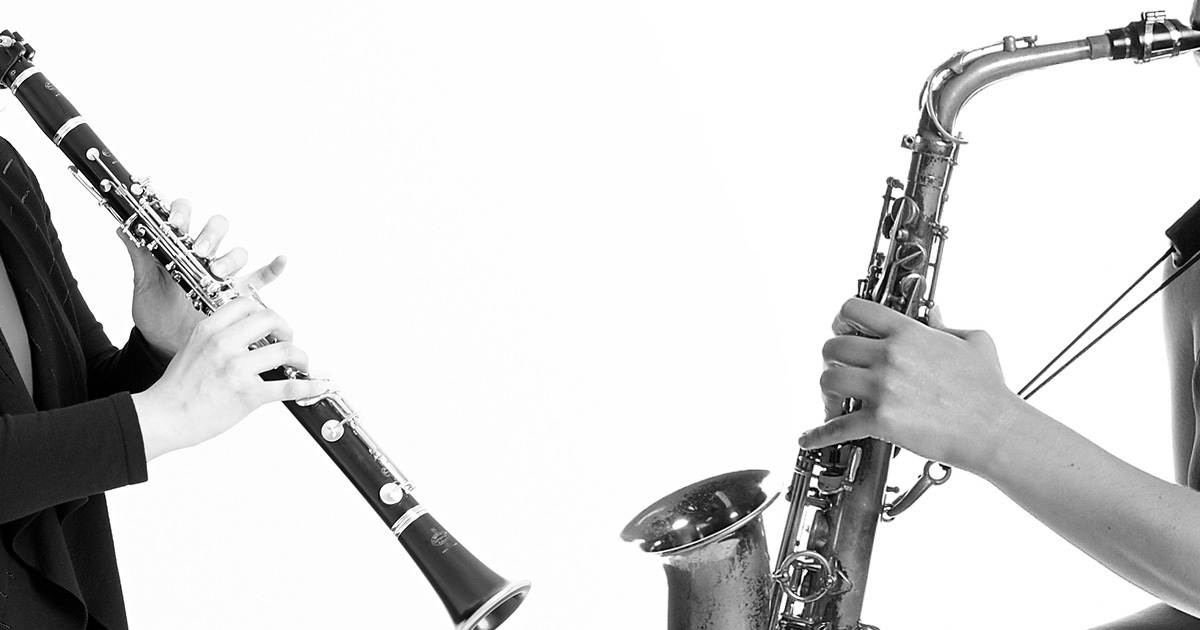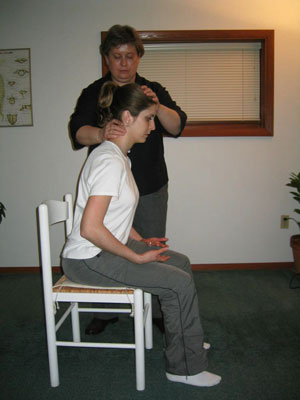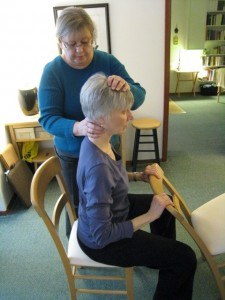How Does the Alexander Technique Benefit Musicians?
An Explanation from Rose Bronec by Rebecca Scholldorf
Date Posted: May 19, 2016

From the age of 23, Rose worked in costume design—sewing theatre, ballet and opera costumes. The pain in her lower back and neck started during work and would plague her for the rest of her life if she didn’t do something about it. She decided to seek professional help and through a referral, tried Alexander Technique, a way to “recognize and redirect patterns of customary muscle tension.” She is now the director of Alexander Technique Urbana: a three-year training program for teachers of Alexander Technique. She has been teaching the technique since 1980.
The inventor, Frederick M. Alexander, was an Australian actor who battled with chronic laryngitis. When none of his doctors could cure it, he developed his technique in the early 1890s and was able to recite his lines with ease. An Alexander teacher like Rose focuses on physical learning (the kinesthetic aspect), stimuli connected to body movement (the proprioceptive aspect), and how we train our minds to relieve muscle strain through self-awareness. With regular exercise and practice, a student can eliminate muscle strain completely.
What does neck tension have to do with musicians?
Rose Bronec: The neck and throat area is a very good register. For me as an Alexander teacher, I’m always watching that area because if that area is fairly free, I know we’re on the right track. But if the neck and throat start to feel tense or restricted in some way, it means that something is interfering with the natural poise of the head. If the neck is fairly free and the throat is fairly free, then the head is just sitting up there doing its job (you could say). A big piece of that job is vision. Whether it’s to read the music, watch the conductor in a musical setting, or to see in everyday life—we use our eyes all of the time.
The head should be able to lead us into whatever we’re undertaking. But, if we start to create extraneous tension, it will interfere with the poise of the head. There will be tension in the throat and neck. Now this doesn’t mean the tension is originating in the throat and neck, it just means it’s a great register for showing us that something is going on; the neck is tensing up.
In Alexander’s example, he figured out that he was creating too much tension in his feet and legs, and that was interfering with his voice—this was just one of the things he noticed.
It’s so individual. I can give you generalizations, but it really comes down to each person, learning to identify your own patterns and habits which may be causing extraneous tension in the throat and neck. That’s how Alexander caught onto it: he watched himself in a three-way mirror, so that he could see himself at all the different angles. He began to understand that he was pulling his head back and as soon as it did that, it was causing pressure on his larynx. Some of his initial response was to observe how complicated it was—we can’t always stop doing what we know we do. He was, to some degree, able to interrupt what he was doing (or as I say “hit the pause button”). Within that space of stopping, you can begin to give yourself or see a new direction. If Alexander directed his neck to stay free, it would stay free momentarily. It’s a domino situation all the time. It’s not so simple that we can find a button and push it, and then we’re over with it. It’s our brains we’re working with here.
Ways to recognize your unconscious behavior patterns:
- Video yourself (simply use a cellphone)
- Set up a three-way mirror
- Ask someone to watch you play and comment on your body
How does playing an instrument affect the body?
Musicians very often conform to their instrument rather than being aware of their general use (what we call “how you use yourself”) and bring the instrument to you, to your general use. Instead, they hold the instrument and contort themselves to accommodate to the instrument. Many times as an Alexander Technique teacher, I help the student identify first “neutral”; which is their position without the instrument. When you bring the instrument in, how does it affect your use, and what amount of that do you have control over? You cannot allow the instrument to distort your body so poorly.

Instruments are weird things because they are in all shapes and sizes and they demand peculiar positions! But lots of times the human body makes it even more peculiar by over-working to accommodate the instrument. If you sit in on a demonstration where someone is playing an instrument, or singing, and you have an Alexander Technique teacher working with them, it’s lovely to hear the sound difference. You get this immediate feedback from the instrument. The person playing doesn’t always hear that but the audience does for sure.
We refer to ourselves as teachers because what we’re doing is educationally based as opposed to treatment or therapy. Even though we do put our hands to guide someone, it is with the purpose of educating the kinesthetic and proprioceptive systems. We educate as a whole, opposed to a more passive treatment. We want your brain involved in learning.
ROSE COMMENTS ON TWO ALEXANDER TECHNIQUE METHODS: “CHAIR WORK” AND “TABLE WORK.”
Chair:
Sitting in a chair and standing up from a chair is something that everybody does multiple times a day. It’s a very common activity and it’s something we do a lot of. If I can assess your use as you sit, stand, and bend to do things, then I can understand more about how you habitually organize yourself to do most things. To some degree how you sit and stand is going to carry over into everything. It allows me to study you and interrupt how you go about sitting and standing, and then to bring about some changes that you will carry out into life.

Table:
The table work gives me the chance to work with you when your nervous system is quieter. When we’re upright, we’re active and to stay balanced there is a lot going on; the body is active to sustain an upright position. When we lie down, that’s our opportunity for stimulus to shut down so the nervous system can be quieter. While in a rest position, I can demonstrate what it feels like to be free of some tensions. After working in a rest position, we go back to the chair and take it to another level of the Alexander Technique.
How did you get inside of the student's kinesthetic experience?
Think about your own experience with music teachers. Usually, a teacher will provide instruction that they have found helpful for themselves. Many times this is not necessarily helpful to that particular student. How do you get inside of that student’s kinesthetic experience? That’s what I think is so unique about Alexander Technique: we’re trained to look at what that particular individual is doing and not to generalize off of other things. You’re helping to build awareness for them, in all life situations.
One of the things that Alexander noted for himself, and then noted it with people he began to teach, is that we tend to run information through what is familiar, what we are used to. How you think and how you do things. As he said, our sensory appreciation of ourselves can be wrong. If someone says you’re doing something wrong, you are going to run through the things you do, and try to sort it out. But the experience in an Alexander lesson is so helpful because it interrupts our sensory experience long enough to entertain different ways of doing things.
If I had only talked to you about your head poise without giving you some experience of what it felt like to have [your head] in a different place, it would have meant something different to you than it did with the additional sensory experience. In your lesson (guided by my hands), I was not only talking to you but was guiding you to a different place. Our kinesthetic system and proprioceptive system could then register a connection with those words. If I had not touched or worked with you but only told you what was wrong, you may have done something even worse! The job of the Alexander Teacher is to help ensure that how you are guiding the student verbally matches up with how you’re guiding them physically. When they walk away from the lesson, their awareness of themselves is more than just mental stimulation—it’s physical awareness as well.
Well, there you have it: the start to solving your body pains and tension. You can kiss that Guinness Book of World Records for pain tolerance goodbye—you deserve better. For those musicians who can’t book an immediate appointment with their Alexander Technique teacher, there’s a do-it-yourself exercise.
Rose explained this with a book resting under my head. (For all of you college kids out there, the nice, 500 page music history textbook will work just fine. Who knows, maybe some nice osmosis for your next exam will occur.)
- You simply want to lie down on your back and lengthen your spine. Allow yourself to sink into a firm surface and have your knees bent towards the ceiling.
- As you’re lengthening, widen your torso with your hands resting comfortably on your stomach.
- This type of rest allows you to observe your tension habits and address them before you get back to your instrument.
- The recommended prescription? Try 2-5 minutes twice a day. This may be the perfect thing for the practice room or any other place you find relaxing.
It was a pleasure talking with Rose and learning about this new technique. For those who can’t talk with an Alexander Teacher, I highly recommend arranging an opportunity. Even if it’s just for two sessions, it will still pay more dividends than no experience at all. Because we use our bodies every day, it is all but natural to want to maintain healthy habits. This technique for some may be the game-changer.
Subscribe to the We Are Vandoren E-newsletter (WAVE) to receive 4 weekly articles for Performers, Students, and Educators